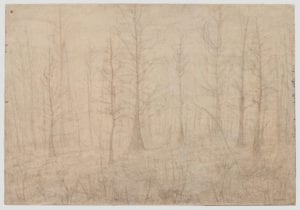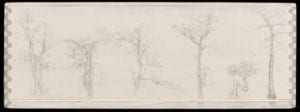Plein-air materials: Silverpoint
By Joseph Weinzettle
Silverpoint, a traditional drawing technique from the Middle Ages, is not typically associated with plein-air drawing. Contrary to convention, I’ve found it well suited to interpreting the forms of native Florida. Silverpoint may be used as a stand-alone drawing technique or as underdrawing for painting. I was introduced to this traditional drawing technique by Mary Fish, my Freshmen Drawing Instructor at the Cooper Union.
Silverpoint is a drawing instrument with high silver content. I’ve used a few different compositions, usually sterling (92.75% silver) or 99.9% pure silver. Silverpoint is less expensive than it sounds, as the amount of silver wire or rod needed for drawing is light in weight and lasts for years. A silver rod about 2 inches, costing $5-$15 dollars, may be inserted into a pin vise or just a home-made wooden holder, called a stylus. Samples of my silverpoint styli below:

Silverpoint is often used by artists for detail studies, or studies of singular objects, but can also used for more expansive landscape drawings. Building up silver tones takes time, and this work below, “Mitigation Area, Dry” was built it up over several years of site visits. The subject is a cypress pond in the dry winter season in Brooker Creek Preserve.

Individual dwarf cypress trees were my subjects in this study from 2010, during my AIRIE Artist-in-Residency in the Everglades, below. I wanted to explore the fine linear qualities of the subject, dwarf cypress, in the Everglades cypress savannah. Silverpoint is a preeminent fine-line drawing technique. Salvaged furniture boards are often my supports for plein–air drawing and painting, and add tangible qualities to the artwork. Working in Everglades National Park made me more aware of native Florida habitat, and inspired me to seek out native trees and landscape in Pinellas County.



